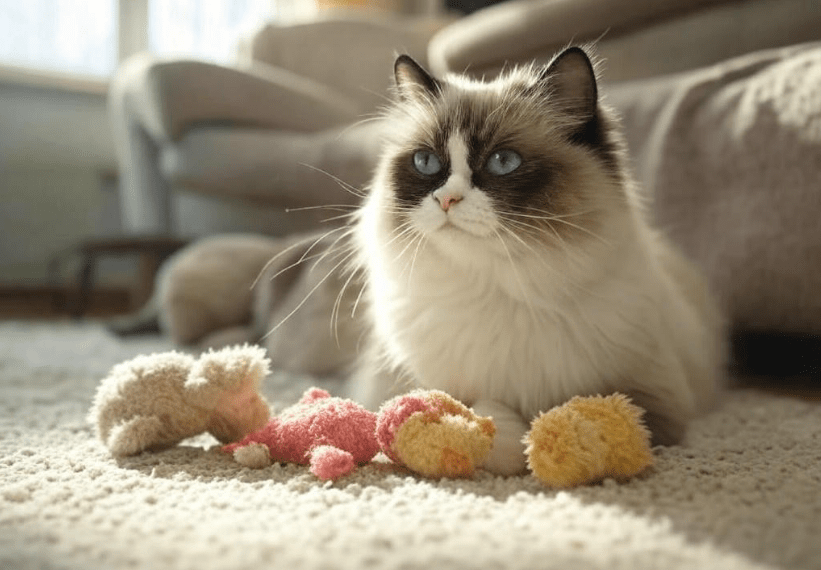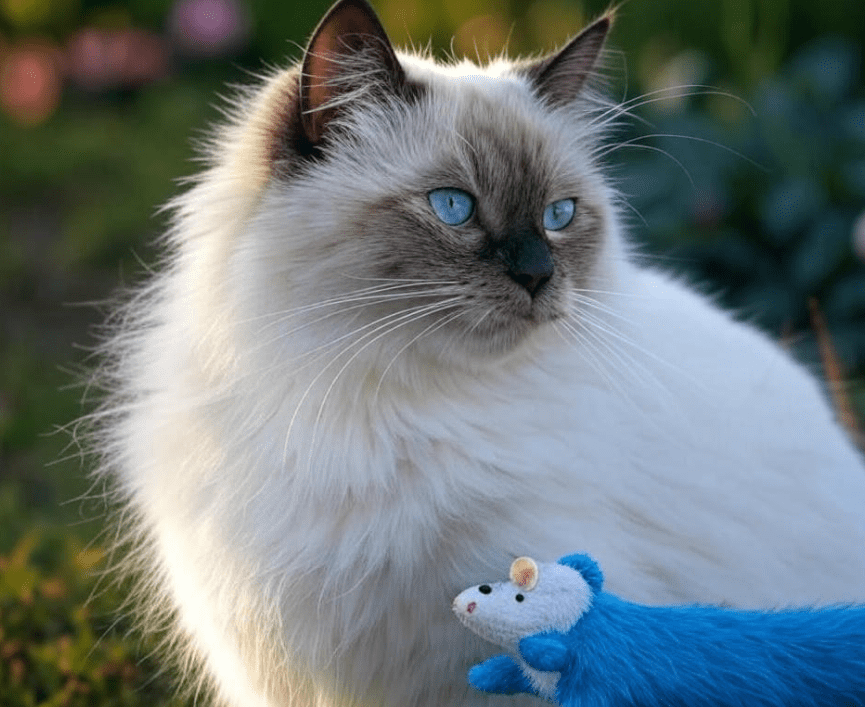
Ragdoll cats, with their affectionate and social nature, often form deep bonds with their owners, making them prone to Ragdoll cat separation anxiety. This condition can manifest as stress, destructive behavior, or vocalization when left alone. As a devoted Ragdoll owner, understanding and addressing separation anxiety is crucial to ensure your cat’s emotional well-being. This comprehensive guide explores the causes, signs, and effective strategies to help your Ragdoll cope with separation anxiety, offering practical solutions to create a calm, happy environment for your feline friend.
Understanding Separation Anxiety in Ragdoll Cats
Ragdolls are known for their dog-like loyalty and love for human companionship. While this makes them wonderful pets, it also increases their risk of separation anxiety when left alone for extended periods. Ragdoll cat separation anxiety occurs when a cat experiences stress or fear due to the absence of their owner or a significant change in routine.
Why Are Ragdolls Prone to Separation Anxiety?
Social Nature: Ragdolls thrive on interaction and may feel isolated without their owners.
Strong Bonds: They often attach strongly to one person, making separation particularly distressing.
Sensitive Temperament: Ragdolls are gentle and sensitive, so changes in environment or routine can trigger anxiety.
Large Size, Big Emotions: Their size doesn’t diminish their emotional needs; they crave attention and reassurance.
Common Triggers
1.Prolonged time alone (e.g., work hours or travel)
2.Moving to a new home
3.Changes in household dynamics (new pets, babies, or roommates)
4.Loss of a companion (human or pet)
5.Inconsistent schedules
Recognizing the Signs of Separation Anxiety in Ragdolls

Identifying Ragdoll cat separation anxiety early is key to addressing it effectively. Look for these behavioral and physical signs:
Behavioral Signs
Excessive Vocalization: Meowing, yowling, or crying when you’re about to leave or while you’re gone.
Destructive Behavior: Scratching furniture, chewing objects, or knocking things over.
Litter Box Issues: Urinating or defecating outside the litter box, especially when alone.
Over-Grooming: Excessive licking or chewing fur, leading to bald patches.
Clinginess: Following you around excessively or demanding attention before you leave.
Hiding or Aggression: Withdrawing to hide or showing unusual irritability when you return.
Physical Signs
1.Loss of appetite or refusal to eat when alone
2.Vomiting or diarrhea triggered by stress
3.Lethargy or reduced playfulness
Vet Insight: “Ragdolls may not always show obvious signs of anxiety. Subtle changes, like avoiding their favorite toys, can indicate distress.” – Dr. Sarah Thompson, DVM
If you notice these signs, consult a veterinarian to rule out medical issues, as conditions like urinary tract infections can mimic anxiety symptoms.
Causes of Ragdoll Cat Separation Anxiety
Understanding the root causes of Ragdoll cat separation anxiety helps tailor solutions to your cat’s needs. Common causes include:
Lack of Early Socialization: Kittens not exposed to alone time may struggle with independence.
Traumatic Experiences: Past abandonment or shelter stays can heighten anxiety.
Routine Disruptions: Inconsistent feeding or play schedules can make Ragdolls feel insecure.
Boredom: Without stimulation, Ragdolls may channel stress into anxious behaviors.
Over-Dependence: Constant attention can make Ragdolls overly reliant on their owners.
10 Proven Strategies to Help Your Ragdoll Cope With Separation Anxiety
Helping your Ragdoll manage separation anxiety requires patience, consistency, and a combination of environmental, behavioral, and emotional strategies. Here are 10 expert-backed methods to reduce stress and build your cat’s confidence.
1. Gradual Desensitization to Alone Time
How It Works: Gradually increase the time your Ragdoll spends alone to build tolerance.
Steps:
1.Start with short absences (5–10 minutes) while your cat is engaged with a toy or treat.
2.Slowly extend absences over weeks, rewarding calm behavior with treats or praise.
3.Avoid making a fuss when leaving or returning to normalize departures.
Why It Helps: Desensitization teaches Ragdolls that being alone is safe and temporary.
Pro Tip: Use a timer to track absences and ensure gradual increments to avoid overwhelming your cat.
2. Create a Safe, Enriched Environment
How It Works: A stimulating environment reduces boredom and stress.
Tips:
1.Provide cat trees, scratching posts, and perches for exploration.
2.Place toys like puzzle feeders or interactive balls to keep your Ragdoll engaged.
3.Set up a cozy “safe space” with a bed or blanket that smells like you.
Why It Helps: Enrichment distracts Ragdolls from your absence and boosts their confidence.
Product Recommendation: Try the KONG Cat Puzzle Feeder ($15, Chewy) to keep your Ragdoll mentally stimulated.
3. Use Calming Products
How It Works: Pheromone diffusers, sprays, or supplements mimic calming signals.
Options:
Feliway Classic Diffuser ($25, Amazon): Releases calming pheromones to reduce stress.
ThunderEase Calming Spray ($15, Chewy): Can be applied to bedding or carriers.
Zylkene Supplements ($30, Petco): A milk-derived calming supplement for cats.
Why It Helps: These products create a soothing atmosphere, easing Ragdoll cat separation anxiety.
Caution: Consult your vet before using supplements, especially for cats with health conditions.
4. Establish a Consistent Routine
How It Works: Predictable schedules provide security.
Steps:
1.Feed, play, and cuddle at the same times daily.
2.Use automated feeders (e.g., PetSafe Smart Feed, $90, Amazon) for consistent meal times.
3.Schedule play sessions before leaving to tire your Ragdoll out.
Why It Helps: Routine reduces uncertainty, helping Ragdolls feel in control.
5. Interactive Toys and Technology

How It Works: Toys and tech keep Ragdolls entertained while you’re away.
Options:
PetCube Play 2 ($200, Amazon): A camera with a laser toy for remote interaction.
Catit Senses 2.0 Circuit ($20, Chewy): A track toy for physical activity.
SnugglyCat Ripple Rug ($40, Amazon): Encourages exploration and play.
Why It Helps: Engagement prevents boredom, a key trigger of anxiety.
Tester Feedback: Ragdoll owners report that PetCube’s laser feature keeps their cats distracted for hours.
6. Introduce a Companion
How It Works: Another pet can provide companionship.
Considerations:
1.Choose a calm, compatible pet (e.g., another Ragdoll or a friendly cat).
2.Introduce slowly to avoid territorial stress.
3.Ensure you can care for multiple pets financially and emotionally.
Why It Helps: A companion can reduce loneliness, especially for social Ragdolls.
Note: Not all Ragdolls enjoy sharing attention; monitor their behavior during introductions.
7. Behavior Modification Training
How It Works: Positive reinforcement rewards calm behavior.
Steps:
1.Reward your Ragdoll with treats for staying calm when you pick up keys or put on shoes.
2.Ignore clingy behavior to avoid reinforcing it.
3.Use clicker training to associate calm behavior with rewards.
Why It Helps: Training builds independence and reduces anxiety triggers.
8. Music or White Noise
How It Works: Soothing sounds mask external noises that may stress Ragdolls.
Options:
1.Play classical music or cat-specific playlists (e.g., “Relax My Cat” on Spotify).
2.Use a white noise machine ($20, Amazon) to block disruptive sounds.
Why It Helps: Calming sounds create a peaceful environment, reducing stress.
Study Insight: A 2019 study in Journal of Feline Medicine and Surgery found that classical music lowers stress in cats.
9. Professional Help
How It Works: Experts provide tailored solutions for severe cases.
Options:
Veterinarian: May prescribe anti-anxiety medication (e.g., fluoxetine) for extreme cases.
Certified Cat Behaviorist: Offers personalized behavior modification plans.
Why It Helps: Professionals address underlying issues and provide advanced strategies.
Cost Estimate: Behaviorist consultations range from $50–$150 per session.
10. Gradual Lifestyle Adjustments
How It Works: Long-term changes prevent recurring anxiety.
Tips:
1.Work from home part-time or hire a pet sitter for long absences.
2.Rotate toys weekly to maintain interest.
3.Spend quality time daily to strengthen your bond.
Why It Helps: Consistent care builds emotional resilience in Ragdolls.
Common Mistakes to Avoid
To effectively manage Ragdoll cat separation anxiety, steer clear of these pitfalls:
Punishing Anxious Behavior: Yelling or scolding can worsen stress and damage trust.
Sudden Changes: Abruptly leaving for long periods without preparation can intensify anxiety.
Ignoring Signs: Dismissing subtle symptoms delays intervention and worsens the condition.
Over-Reliance on Medication: Drugs should complement, not replace, behavioral strategies.
Neglecting Enrichment: A boring environment fuels anxiety and destructive behavior.
When to Seek Veterinary Help
If your Ragdoll’s anxiety persists despite your efforts, consult a veterinarian. Seek help if you notice:
1.Severe symptoms (e.g., self-harm, refusal to eat for over 24 hours)
2.Physical symptoms like vomiting or diarrhea
3.Behavioral changes lasting more than 2–3 weeks
4.Aggression or extreme withdrawal
A vet may recommend blood tests, behavioral assessments, or medication to manage severe Ragdoll cat separation anxiety.
Preventing Separation Anxiety in Ragdoll Kittens
Prevention is easier than treatment. Start early with these tips for Ragdoll kittens:
Socialize Early: Expose kittens to short periods alone and various stimuli (e.g., sounds, people).
Encourage Independence: Avoid constant cuddling; let them explore solo.
Provide Enrichment: Offer toys and perches to build confidence.
Stick to Routines: Consistent schedules create security from a young age.
Breeder Advice: “Ragdoll kittens raised with gradual alone time are less likely to develop separation anxiety.” – Jane Miller, Ragdoll breeder
Conclusion

Helping your Ragdoll cope with Ragdoll cat separation anxiety requires understanding their unique needs and implementing a combination of desensitization, enrichment, and calming strategies. From creating a stimulating environment to using tools like Feliway or PetCube, the 10 strategies outlined above offer practical, vet-approved solutions to reduce stress and build your cat’s confidence. By avoiding common mistakes, establishing routines, and seeking professional help when needed, you can ensure your Ragdoll feels secure, even when you’re away.
Share your experiences or favorite tips for managing Ragdoll cat separation anxiety in the comments, and let’s help other Ragdoll owners create a stress-free home for their feline friends!




